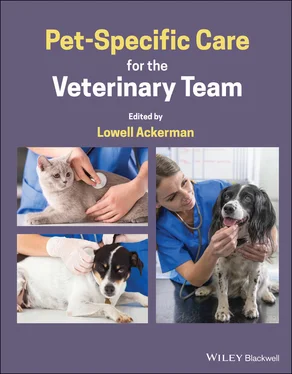bAn elbow result is a two‐letter breed code followed by EL that indicates the number is associated with elbows, the evaluation number, an abbreviation of the sex of the dog (M = male; F = female), and the age of the dog in months when the elbows were evaluated.
cAn eye result is a two‐letter breed code followed by either the abbreviation EYE that indicates the number is associated with eyes or just the evaluation number.
dA thyroid result is a two‐letter breed code followed by TH that indicates the number is associated with thyroid, the evaluation number, and the age of the dog in months when the thyroid was evaluated.
Dogs are the companion species with the greatest number of health screens available; these screens range from phenotypic tests such as hip conformation, eye, cardiac, or metabolic hormonal profiles to direct genetic mutation tests (see 3.11Integrating Genotypic and Phenotypic Testing). Depending upon the registry, any and all health information may be collected and reported along with descriptive statistics such as sex, breed, age, etc. Alternatively, a select subset of screening tests that meet particular criteria may be recorded along with the descriptors. An example of the latter is the OFA Canine Health Information Center health registry, the largest repository of canine health information in the US, which covers purebred dog breeds as well as mixed‐breed dogs and some other species. The health screening data recorded and published by the OFA are limited to phenotypic results obtained through examinations and testing by professional veterinarians with the appropriate board certifications and DNA‐based results from validated genetic tests ( Table 3.7.3).
Table 3.7.3 Genetic test screenings recorded in the OFA Canine Health Information Center health registry
Source: Data from www.ofa.org.
| Phenotypic genetic tests |
Mutation tests |
| Hip dysplasia |
Adult‐onset neuropathy |
| Elbow dysplasia |
Adult paroxysmal dyskinesia |
| Cardiac disease |
Basenji progressive retinal atrophy |
| Congenital deafness |
Canine multiple system degeneration |
| Serum bile acid |
Degenerative encephalopathy |
| Eye disease |
Degenerative myelopathy |
| Legg–Calvé–Perthes |
Dilated cardiomyopathy |
| Patellar luxation |
Fanconi’s syndrome |
| Sebaceous adenitis |
Gangliosidosis |
| Spine |
Juvenile laryngeal paralysis and polyneuropathy |
| Shoulder osteochondrosis |
Neonatal cerebellar ataxia |
| Thyroid |
Neuronal ceroid lipofuscinosis |
| Tracheal hypoplasia |
Neonatal encephalopathy with seizures |
| Dentition |
Pyruvate dehydrogenase phosphate deficiency |
| Kidney |
Primary lens luxation |
|
RCD4 progressive retinal atrophy |
|
Spinocerebellar ataxia |
|
Spongiform leukoencephalomyelopathy |
In contrast, some individual dog breed clubs maintain their own health databases managed by dedicated club members. These breed‐specific health registries usually catalogue health conditions more typically observed within that breed as well as collecting information on a multiplicity of medical conditions. The information gathered and recorded often includes anecdotal descriptions of health issues. Although professional diagnoses are the most valuable for reliable use in decision making, sometimes aggregate anecdotal information reveals an emerging health issue.
Health screening results for cats can also be deposited with the OFA, although participation has been limited. The reduced data may be due to fewer health screens being typically employed by cat owners or that the health registration for cats is more decentralized and maintained within breed clubs. A similar breed‐specific approach is seen for equine health registries. Additionally, some registries are specific for a particular condition within a specific breed, such as the International Epilepsy Register for Belgian Shepherds. Registries targeting a single condition or those more anecdotal in nature are much less valuable to the veterinary and research community than the registries that are more comprehensive and centralized with health screenings validated by professionals.
3.7.5 Research Organizations
In general, research into the inheritance and genetic basis of health conditions occurs within university laboratories, institutes, veterinary organizations, and commercial genetic testing enterprises. The research is frequently undertaken in collaboration with veterinary professionals and owners, often relying upon information contained within health registries. An emerging model in some countries as well as in large veterinary companies with multiple hospitals is the wholesale collation of health records from individual veterinary practices for the purpose of facilitating research. Financial support for research into companion animal medical conditions comes in the form of grants from private foundations including the Canine Health Foundation, Morris Animal Foundation, Winn Feline Foundation, Grayson‐Jockey Club Research Foundation, and the Sport Horse Research Foundation as well as federal granting agencies when the work directly supports human health. Additionally, veterinary specialty board organizations may direct funds for the research of targeted health conditions, such as the American College of Veterinary Ophthalmologists and vision loss. Private foundations rely upon philanthropic donations to support their grant funding activities whereas commercial enterprises generally reinvest a portion of the resources obtained from marketing and sales of DNA testing.
The objective of the research is to develop predictive tools for owners and veterinarians to better manage health conditions in companion animals. Outcomes of research are phenotypic tests such as orthopedic, cardiac, ocular, and metabolic screenings that can be deployed generally once validated by healthcare professionals. Genetic mutation tests are the ultimate goal of the research as they are most predictive in disease expression or the propensity of an individual to pass genetic risk on to the next generation (see 3.6Genetic Testing). In the absence of the mutation test, linked tests may provide guidance although caution must be applied due to the lack of accuracy of such linked tests.
Health screening diagnostics developed through research must be properly validated across many unrelated individuals living in varied locations and exposed to different environments to assess general applicability of the test. Prior to incorporating testing is an understanding of limitations that might exist for a given test in order to manage those limitations and expectations. Genetic mutation tests are usually 100% accurate; however, accuracy relies upon the generalizability of the test across breeds, the testing procedure, and the quality of the genetic testing laboratory. Ideally, researchers subject their findings to the peer review process prior to making a proposed test available.
Health registries provide the information background for researchers seeking to establish the genetic underpinnings of disease. With widespread owner participation, researchers can identify families or breeds having a high prevalence of a particular disease and then characterize inheritance and collect appropriate DNA samples for genetic studies.
Health testing is important for all companion animals because mixed‐breed and purebred pets all have the possibility for disease. Knowledge that there is a predisposition for disease will permit the owner and veterinarian to best care for the pet long term (see 1.2Providing a Lifetime of Care). Some diseases may be treatable or have limited impact on a dog's quality of life whereas others may require aggressive intervention. Broad‐scale testing and submission of those test results to a health registry provides the needed data to permit confidence in predicting health risks.
Читать дальше












